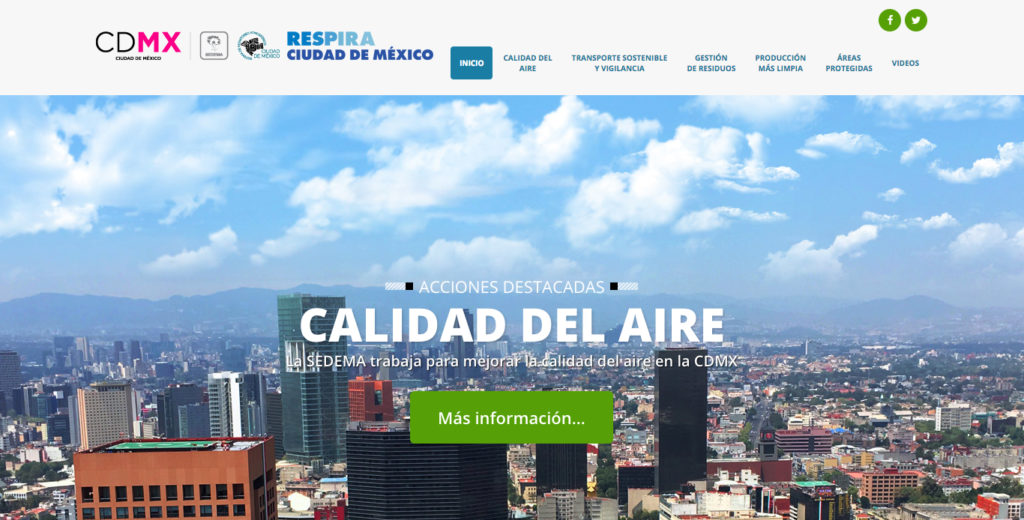Mexico City, home to more than 8.8 million people, the point of greatest concentration of human activity in the country, joins the BreatheLife campaign on the Inter-American Day of Air Quality (Día Interamericano de la Calidad del Aire) 2018.
Its geographical situation and socioeconomic context make demographic growth and urban structure increasingly important and regionally complex.
The different institutions of Mexico City´s government (CDMX) have been working in coordination for many years on improving air quality with the purpose of improving quality of life and prosperity for the inhabitants under a vision of sustainable development. Most of the progress has been made through comprehensive air quality management programs (PROAIRE) based on scientific, technical, social and political considerations.
Mexico City has coordinated with the federal government and the surrounding states to implement actions to address the regional (megalopolis) environmental issues. In addition, Mexico City has implemented an integrated policy for air quality and climate change, including priority strategies to protect public health.
Information and knowledge as a key air quality management tool:
Mexico City has an extensive data collection capacity, including comprehensive ambient air quality monitoring system and emissions inventory, which provide air quality information to the public and also an important tool for designing, implementing and evaluating air pollution control policies. An air quality forecasting system has been implemented in 2017 to alert the public of high pollution event 24 hours in advance. Mexico City is one of the few cities in which partnership with national and international scientific community has continued and strengthened over time. Information obtained from recent field measurement campaigns, including MCMA-2003 and 2006 MILAGRO, have provided comprehensive information on the emissions and the transport of pollutants, and contributed to the design of the current air quality management program.
Successful air quality management actions:
Recognizing Mexico City air pollution as a major environmental and social concern, Mexico City´s government started developing and implementing comprehensive air quality management programs in the 1990s that combined regulatory actions with technological change. Specific actions included removal of lead from gasoline, implementation of catalytic converters in automobiles, reduction of sulfur content in diesel fuel, closure of an oil refinery, substitution of fuel oil in industry and power plants with natural gas, reformulation of liquefied petroleum gas for cooking and heating, reinforcement of vehicle inspection and maintenance program, and implementation of “no driving day (Hoy No Circula)” rule. As a result of these emissions reduction measures, the concentrations of criteria pollutants have been decreasing over the past decade.
Mexico City government has continued to strengthen the vehicular emissions control with advanced technologies and surveillance programs, including Green inspectors and remote sensors to identify high emitting as well as non-compliance vehicles; improve fuel quality for both diesel and gasoline; improve public transportation (Metrobus); equip buses with newer diesel technologies; introduce Hybrid and electric taxis; improve mobility through bike-sharing program (Ecobici) and enhanced pedestrian areas.
Mexico City has also implemented climate change strategic programs with clear and specific targets, including green energy (e.g., solar panels), energy efficiency programs for public buildings, and sustainable development of natural resources and biodiversity.
With health and environmental policies aimed at reducing air pollution, the city is seeing cleaner air even as it continues to expand and grow. The densely populated urban area is an ideal place to put clean air policies to work — and help save thousands of lives.
Mexico City is pursuing several key initiatives in its clean air program.
Efficient mass transit
The city is improving mobility by upgrading its high-capacity, low-emission transport systems and improving the maintenance and inspection program for private vehicles.
Solid waste management
The city plans to improve collection and disposal of solid waste with more efficient solutions — including potentially using landfill gas recovery to supply clean energy. Residents are also following new trash and recycling regulations.
Energy-efficient buildings
One key initiative is an intensive program to replace lamps with better technology. A new project to convert four public buildings to efficient energy usage was recently approved.
Renewable power supply
Mexico City invests in renewable power projects like installing photovoltaic panels on public and private buildings to generate renewable energy and installing solar water heating in 26 hospitals.
Reduced burning of agricultural waste
Through fire prevention workshops, treatment of controlled burns and more activities, Mexico City is helping to regulate the open burning of agricultural wastes. A buffer zone is being created between the agricultural and forest areas.
Read the press release here: CIUDAD DE MÉXICO SE UNE A LA CAMPAÑA BREATHELIFE
Follow Mexico City’s BreatheLife journey here:
And here on the BreatheLife website.
